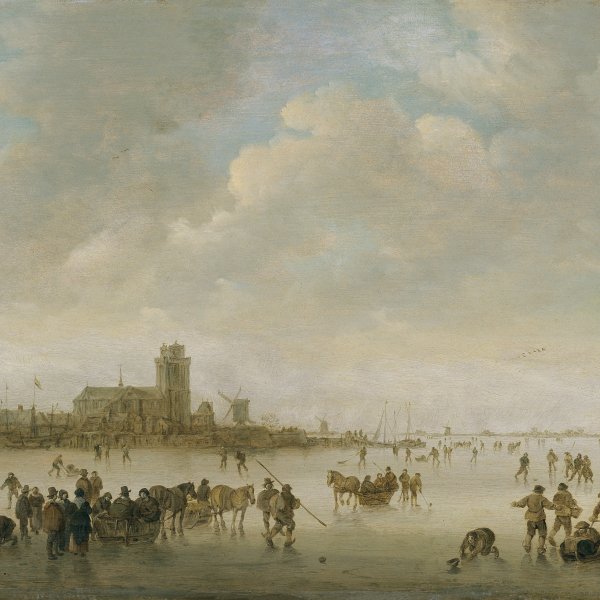Portrait of a Man
1640
Oil on panel.
67.1 x 55.1 cm
Museo Nacional Thyssen-Bornemisza, Madrid
Inv. no.
143
(1930.22
)
ROOM 27
Level 2
Permanent Collection
Son of a cloth merchant, Govert Flinck began his training in the studio of the painter and preacher Lambert Jacobsz. in Leeuwarden, where he remained until 1633. There he met the painter Jacob Adrianesz. Backer whose influence has been detected in a series of early drawings by Flinck. According to the account by Houbraken, the two artists travelled together to Amsterdam to continue their studies in Rembrandt’s studio where Flinck spent around three years. In Amsterdam he lived in the house of the artist and merchant Hendrick van Uylenburgh who had a school in which pupils learned the rudiments of painting by copying other works. Like Backer and Ferdinand Bol, Flinck’s early works reveal the influence of Rembrandt and Flinck carefully assimilated his teacher’s style, as Houbraken noted. His first known works, possibly executed when he was already an independent master, are dated to 1636 and are now in the Rijksmuseum, Amsterdam, and the Herzog Anton Ulrich Museum in Brunswick. Throughout his career Flinck produced history paintings and portraits.
The present portrait of an unknown sitter is signed and dated 1640. It reveals the clear parallels between Flinck’s work and the style that Rembrandt had evolved in his early years in Amsterdam. These similarities are to be seen in two elements: the type of composition and the effects of light. With regard to the composition, the panel has been compared to two portraits by Rembrandt that have a very similar background and approach to the presentation of the figure, namely the portrait of Maerten Looten of 1632 and that of Herman Doomer of 1640. Looten, a wealthy merchant active in Leiden and Amsterdam, is depicted in three-quarter length with the same turn of the head as the present sitter. The portrait of Doomer, a gilder and maker of mouldings and frames, is notably similar to the present panel with regard to its composition and dates from the same year. Flinck also used this type of composition in his portrait of Rembrandt in the National Gallery, London, which dates from 1639 and is thus slightly earlier than the present panel. In these four images the figure is presented against a neutral background, modelled by the light and with the face turned in three-quarter profile towards the viewer.
Flinck’s style became more complex during the 1640s through his assimilation of the style of another two celebrated artists, Bartholomeus van der Helst and Anthony van Dyck. As a result, the backdrops and settings in his portraits become more elegant and reflect his sitters’ social status, aided by their gestures and the objects that accompany them. His use of colour also changed at this period and came closer to Flemish models.
The present panel entered the Thyssen-Bornemisza collection in 1930. It was shown in four exhibitions during the 1920s during the time it was with the Amsterdam dealer Jacques Goudstikker.
Mar Borobia
The present portrait of an unknown sitter is signed and dated 1640. It reveals the clear parallels between Flinck’s work and the style that Rembrandt had evolved in his early years in Amsterdam. These similarities are to be seen in two elements: the type of composition and the effects of light. With regard to the composition, the panel has been compared to two portraits by Rembrandt that have a very similar background and approach to the presentation of the figure, namely the portrait of Maerten Looten of 1632 and that of Herman Doomer of 1640. Looten, a wealthy merchant active in Leiden and Amsterdam, is depicted in three-quarter length with the same turn of the head as the present sitter. The portrait of Doomer, a gilder and maker of mouldings and frames, is notably similar to the present panel with regard to its composition and dates from the same year. Flinck also used this type of composition in his portrait of Rembrandt in the National Gallery, London, which dates from 1639 and is thus slightly earlier than the present panel. In these four images the figure is presented against a neutral background, modelled by the light and with the face turned in three-quarter profile towards the viewer.
Flinck’s style became more complex during the 1640s through his assimilation of the style of another two celebrated artists, Bartholomeus van der Helst and Anthony van Dyck. As a result, the backdrops and settings in his portraits become more elegant and reflect his sitters’ social status, aided by their gestures and the objects that accompany them. His use of colour also changed at this period and came closer to Flemish models.
The present panel entered the Thyssen-Bornemisza collection in 1930. It was shown in four exhibitions during the 1920s during the time it was with the Amsterdam dealer Jacques Goudstikker.
Mar Borobia









